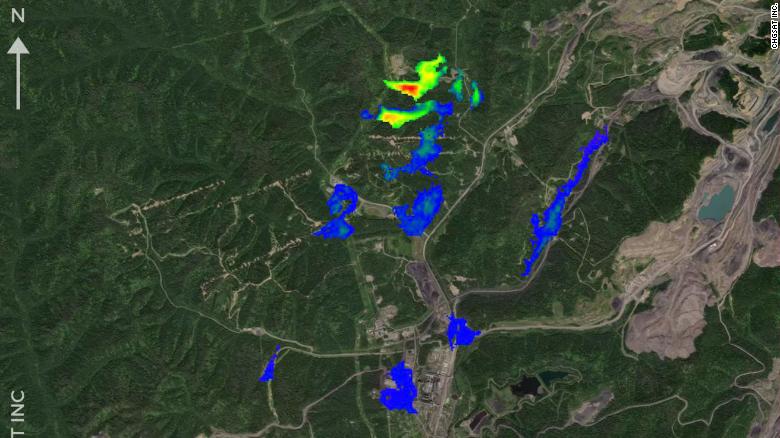Methane emissions, at their highest level in history 1:21
(CNN) --
A coal mine in a remote part of Russia is spewing huge amounts of a potent greenhouse gas in what has been described as the "largest" leak of methane ever detected from a single facility.
The Raspadskya mine, located in the Kemerovo region of southern Russia, releases nearly 90 tons of methane every hour, according to new data from GHGSat, a company that uses satellites to monitor methane leaks from space.
The company said it detected 13 separate methane plumes during a satellite pass on Jan. 14, 2022, and observed more plumes at a later date.
Throwing lightning at cow dung helps trap methane that contributes to climate change
Stephane Germain, founder and president of GHGSat, told CNN Wednesday that the January 14 leak was not an isolated incident: The company has detected consistent leaks at the facility for the past five months.
"We found big leaks all over the world, but this one stood out," he said, adding that it was the biggest leak ever recorded and traced back to its source.
advertising
GHGSat said that if the emission continued at the same rate for a year, the mine would emit more than 764,000 tons of methane, which is equivalent to the amount of natural gas needed to power 2.4 million homes for a year.
Raspadskaya, the company that operates the mine, did not immediately respond to CNN's request for comment.
After carbon dioxide, methane is the second largest contributor to human-caused climate change.
An image from GHGSat shows the methane leak in Russia.
Methane is the main component of natural gas used for heating homes and cooking, and it can leak from coal mines, oil and gas platforms, and pipelines that transport fossil fuels.
It also comes from landfills and agriculture, with cow burps being one of its biggest sources.
For a long time, methane was not considered a problem because its total emissions are significantly lower than those of CO2.
However, this gas has a heating power approximately 80 times greater in the short term than CO2 and, according to the UN Intergovernmental Panel on Climate Change (IPCC), the concentration of methane in the atmosphere is older now than at any time in at least 800,000 years.
Historical emissions caused the climate crisis.
But what we do today is what will define its course, according to a study
"To look at it another way, methane is the easy win for the world," Germain said.
"If we can find the sources of methane around the world, it can have a very big short-term impact on climate change. And that's why it's so important that we find the sources and work with the operators and with the regulators to find ways to reduce those emissions.
Methane is difficult to detect because it is invisible and odourless.
GHGSat uses six satellites with high-resolution spectrometers that make the methane visible and can pinpoint the exact source of the leaks.
"Each gas in the atmosphere absorbs light at a specific wavelength, each gas has a 'spectral fingerprint,' and the spectrometer looks for those fingerprints," Germain explained.
Germain says the leak in Russia is part of a broader trend the company is seeing around the world.
"Coal mining emissions have increased significantly in the last year. We've seen it in China. We've seen it in Russia. We've seen it in the United States. We've seen it in Australia, so consistently, to us, this indicates that there has been an increase in coal production," he said.
The deal to cut coal use was one of the main points of discussion at the COP26 climate summit in Glasgow last year, with countries finally agreeing to "reduce" consumption as part of their efforts to keep rising global temperature as close as possible to 1.5 °C.
Germain said that the increase in coal production is related to the increase in gas prices.
"Countries that have coal resources are probably very interested in having alternative energy sources that are cheaper than gas today. That's what we think we're seeing, and frankly, it's very unfortunate." , said.
There is a 50/50 chance that the world will pass the critical global warming threshold in the next five years
GHGSat said the large release of methane from the Raspadskya mine could be intentional and related to mine safety.
He explained that methane is an unavoidable by-product of mining and that the gas needs to be released during the extraction process.
A large accumulation of methane in underground tunnels could be extremely dangerous because it is an explosive gas.
Miners at the Raspadskaya mine have already suffered deadly consequences;
in 2010, a gas explosion at the mine killed more than 60 people.
With the planet fast approaching 1.5°C of warming above pre-industrial levels, scientists have warned that atmospheric methane must be brought down quickly.
1.5°C has been identified as a critical threshold and keeping warming as close to this point as possible is the key objective of the historic Paris climate agreement.
-- CNN's Jessie Yeung contributed to this report.
Climate changeGreenhouse gasesSatellite

